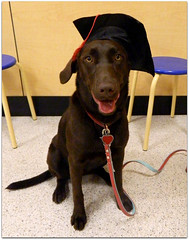 |
| Puppy Training Graduation (Photo credit: hihihellokitty) |
Teach Your Puppy to Obey
Your puppy is part of the family, and it makes sense you want to train him humanely. This article will describe some puppy training tips that will help you in your efforts. You need to start by educating yourself on puppy training before you can start properly educating your puppy.
Make sure you aren't enforcing bad behavior without meaning to. This means denying your puppy treats and praise whenever it misbehaves. For instance, it will be difficult or impossible to train your puppy not to jump on people if you give your pet a friendly neck-scratch when he or she jumps on you. When training a puppy to a leash it is important to keep the leash loose.
Puppies like to explore new places when they are out on a walk. Eager puppies will begin to put some strain on their leashes. Smart pet owners will make sure the pet walks on a leash with some slack to it. As part of good training, you should learn if your dog's breed requires special grooming. Some puppys require a small amount of grooming, while others may require meticulous grooming each week. Grooming keeps your dog happy and clean, and greatly reduces the risk of disease.
When traveling with your pet, ensure you pack all the necessary equipment. Things such as food and water bowls, paper toweling and waste bags are critical for a smooth trip.
Command your puppy to sit before it gets fed or walked. If you continually reinforce your training, the puppy is sure to learn to always follow commands. If you only use certain commands in certain situations, your puppy will not understand that he must listen to them at all times. Research to see which training methods work best for your specific dog breed. Different breeds learn at different speeds. For example, bull puppies and basset hounds require time and patience for effective training.
When your dog is a room make sure you are calm when you come in. Playtime with them is great, however, they must learn to be calm when you're entering a room.
"No" shouldn't be a huge part of training. Find some positive ways to enforce training when you train your puppy. Saying 'no' doesn't help your puppy understand how he should react to you. Make sure that your training regimen is unique to your specific puppy. When you go out with your dog, always pay attention to other puppies and animals you come across. There are some puppys that are aggressive for reasons that have nothing to do with their owners. If you come across an aggressive puppy, make sure to steer your own puppy clear of it.
Although it can be very difficult at times, patience should always be used with your puppy. Sometimes we forget that our pets don't understand our language, much less our thoughts.
To keep your puppy from biting at furniture or people, or scratching at doors, spray him or her with a bottle of water. This will teach your puppy that there are certain behaviors that are unacceptable. Before long, your puppy will no longer display these behaviors, and will be obedient and playful. Learn what your puppy's signals are in order to prevent future accidents indoors. Dogs will let you know when they have to go. Understanding this pattern can help to avoid hazards around the house. Getting in sync with the natural tendencies of your puppy will make house training a whole lot easier.
Use positive reinforcement when training your puppy. Instead of punishing him when he is bad, simply do not reward that behavior.
Just say no, and then show it what to do instead. Let your puppy know that if you raise your voice they need to pay attention. If you're going to allow your puppy the chance to go bathroom inside, make sure there is a dedicated area for this. Line the area with potty pads and slowly shrink the size of the spot until just one potty pad designates the exact spot you have set aside for their use. When training a puppy to a leash it is important to keep the leash loose. When they're on a walk, they are anxious to check things out. Their enthusiasm will lead to a large amount of strain being applied to their leash. Smart pet owners will make sure the pet walks on a leash with some slack to it.
When you start puppy training, come up with a verbal cue that will tell your pet they've followed your command. The word "yes" can be the bridge between rewards and good behavior.

No comments:
Post a Comment